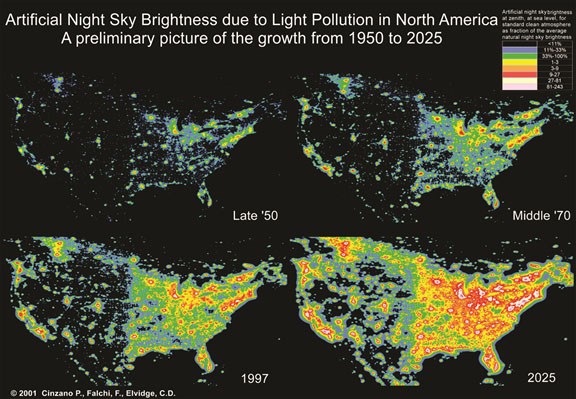By Ember Snook
Looking
up at night at the moon, it's easy to marvel when you can see a star or two
twinkling by the wayside. Even when it turns out to be just another airplane
slipping silently through the clouds, it's easy to shrug and forget that once,
one could see a sea of starlight. Light pollution has become a constant reality
in our world, and it's one we all too often set aside as both impossible to
regulate and 'harmless.' Spoiler: pollution is never harmless.
Scientists
have, as with most other pollutant problems, taken a look at the problem of
light pollution. One Korean study encapsulates that nicely for us, pointing out
that artificial light is harmful " due to a disrupted circadian rhythm—an
internal clock that regulates most of the physiological systems in
mammals" (2). While our night-light addiction is proven to be harmful for
many animals (most obviously including moths, but to all manner of nocturnal
creatures like owls), it's hard to get people concerned when there is no danger
to them. Yet, the study points out that we should be concerned because this
disruption of the natural circadian rhythm "it has been linked to simple
discomforts such as fatigue, reduced work productivity and so forth. It has also
been linked to much more grave conditions including diabetes and many different
forms of cancer" (2). Specifically, they present the fact that scientific
study "links breast cancer to artificial lighting exposure" (2). This
is a startling revelation when one takes a look at the night sky - as any of us
living in or near a big city can attest, there's no shortage of well-lit skies,
streets, buildings even at the deadest hours of night.
Light
gets everywhere. Dealing with light pollution is a murky, difficult issue -
streetlights are there to keep people safe, after all. For both drivers and
pedestrians, that bright light is meant to illuminate the surroundings and to
save lives. Billboards and businesses can't afford to turn off their lighting
at night - if you hide an advertisement, after all, you're losing all of the
eyes that might see it from 8pm to 5am, while any business knows that if they
have no lights on in your store after hours they're just begging to be robbed.
Turning off the lights, even at one's own home, is a dubious prospect. Without
the nightlight in the bathroom, someone might run face-first into the doorjamb
- and when everyone else has their lights on, too, it's easy to think
"just one more won't hurt. How much more polluted can it get?"
We need
to stop that way of thinking - whether it comes to lights, or plastic, we're
causing measurable harm to our environment (not to mention blotting out the
stars in the process). After all, one light does hurt - one of the most
startling things I unearthed is this map of the growing problem of light
pollution over the last 60 years in the United States, presented by the
National Parks Service website:
Source: National
Parks Service, https://www.nps.gov/subjects/nightskies/growth.htm
This map
is particularly striking because you can see the infectious spread of bright
lights across the field of black. The dark night 11 years ago was slowly
bleeding its way into the last unlit corners of the United States. But unlike
other forms of pollution, light pollution is one that's easy for us to manage,
and even reverse entirely overnight.
Even
starting just at home, the best solution is simply to minimize your impact.
Turn off any lights you're not using any more. Turn off appliances that create light that you do not need on.
For lights that you do need, especially security lights or night lights, make
sure they're attached to motion sensors that will turn them off when they are
no longer needed. Encourage others to do the same - and make it a point to ask
your company to dim the lights that they don't need. Every light that is off is
one less source of light pollution. Light pollution is easy, physically, to
stop - but the problem is that no one is eager to confront the monster in
court. If we can culturally change our approach to how we light up our world,
we can both improve our health and reclaim that starlit skies that our parents
seem to reminisce on endlessly!
Sources:
https://www.nps.gov/subjects/nightskies/growth.htm
https://www.nps.gov/subjects/nightskies/growth.htm
Hong Soo Lim et al. "The Reality of Light Pollution:
A Field Survey for the Determination of
Lighting
Environmental Management Zones in South Korea." Sustainability, vol. 10 iss.
2, Feb. 2018.

No comments:
Post a Comment